
Johann Heinrich Friedrich Link was a German naturalist and botanist. The standard author abbreviation Link is used to indicate this person as the author when citing a botanical name.

Agathosma is a genus of about 140 species of flowering plants in the family Rutaceae, native to the southern part of Africa. Common names include Buchu, Boegoe, Bucco, Bookoo and Diosma. Buchu formally denotes two herbal species, prized for their fragrance and medicinal use despite their toxicity. In colloquial use however, the term is applied to a wider set of fragrant shrubs or substitutes.
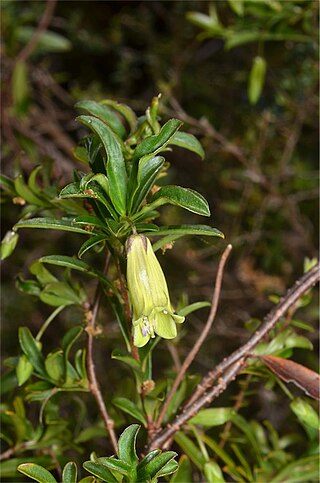
Billardiera longiflora is a species of flowering plant in the family Pittosporaceae and is endemic to Tasmania. It is a woody twiner or climber that has variably-shaped, often elliptic leaves, often varying with altitude, and greenish-yellow, pendent, tube-shaped flowers arranged singly and turning blue as they age. This species is often confused with the similar Billardiera macrantha of south-eastern Australia, including Tasmania.

Eucalyptus longifolia, commonly known as woollybutt, is a species of medium-sized tree that is endemic to eastern Australia. It has thick, fibrous bark on the trunk and larger branches, lance-shaped to curved adult leaves, flower buds in groups of three, white flowers and cup-shaped to cylindrical or hemispherical fruit. The drooping flower heads in groups of three are a distinguishing feature. It grows in heavy soils often near water.
Christoph Friedrich Otto was a German gardener and botanist.
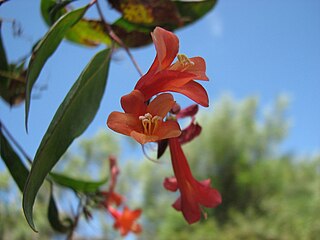
Marianthus is a genus of flowering plants in the family Pittosporaceae and is endemic to Australia. Plants in the genus Marianthus are shrubs with twining branches, simple leaves arranged alternately along the stems. The flowers are pendent, arranged singly or in small groups in upper leaf axils or on the ends of branches with small bracts and bracteoles at the base, but that fall as the flowers open. The sepals are free from each other, and the petals are also sometimes free from each, otherwise joined at the base, forming a tube with spreading lobes. Plants in this genus were previously included in Billardiera, but have a stalked ovary and a long, usually curved style. The fruit is a dehiscent capsule containing many seeds.

Jasminum tortuosum is a species of jasmine native to South Africa. It is generally found twining high into the trees of forests in southwestern part of Cape Province, but also may scramble where there is little vertical space. It has angular branches off its main stem, and its flowers usually have five white petals each. The specific epithet (tortuosum) is from Latin, describing something that is winding or very twisted.

Marianthus erubescens, commonly known as red billardiera, is a twining shrub or climber of the pittosporum family, Pittosporaceae. The species is endemic to the south-west of Western Australia. It has glossy lanceolate leaves that are 20 to 30 mm long. Red tubular flowers appear in spring and sporadically throughout the year.

Elaeocarpus costatus is a species of flowering plant in the family Elaeocarpaceae that is endemic to Lord Howe Island. It is a tree with lance-shaped to elliptic leaves with wavy-toothed edges, flowers in groups of eight to ten, and blue fruit.

Melaleuca rugulosa, commonly known as scarlet bottlebrush, is a plant in the myrtle family, Myrtaceae and is endemic to South Australia and Victoria in Australia. It is a shrub with an open straggly habit, stiff, sharply pointed leaves and bright red bottlebrush flowers tipped with yellow in summer.

Eremophila foliosissima, commonly known as poverty bush, is a flowering plant in the figwort family, Scrophulariaceae and is endemic to Western Australia. It is a small, erect, densely foliaged shrub with long, narrow, hairy leaves and mauve to purple flowers. It is similar to Eremophila gilesii but is more dense and rounded, has more crowded leaves and has different hairs on the flowers.

Billardiera fusiformis, commonly known as Australian bluebell, is a species of flowering plant in the family Pittosporaceae and is endemic to the south-west of Western Australia. It is a sturdy, shrubby climber that has linear to narrowly elliptic leaves and blue, white or pink, nodding flowers arranged singly or in groups of up to four.
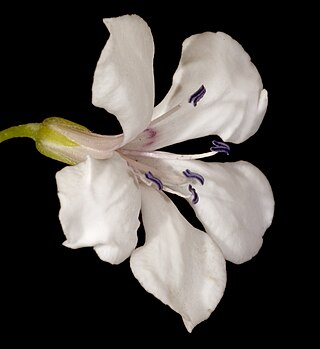
Marianthus candidus, commonly known as white marianthus, is a species of flowering plant in the family Pittosporaceae and is endemic to the south-west of Western Australia. It is a twining shrub or climber with elliptic leaves and white flowers arranged in groups of twenty to thirty and becoming fawn or pink as they age.

Aeonium dodrantale is a species of tree houseleek in the family Crassulaceae.
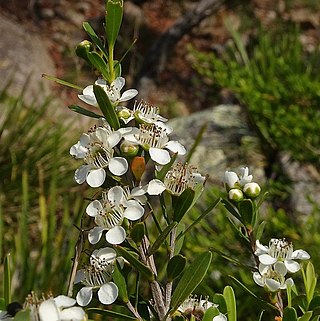
Leptospermum emarginatum, commonly known as the twin-flower tea-tree or twin flower teatree, is a species of shrub that is endemic to south-eastern Australia. It has rough bark on the older stems, lance-shaped leaves with the narrower end towards the base and a small notch at the tip, white flowers in groups of up to five and hemispherical fruit that falls off when mature.

Pomaderris phylicifolia, commonly known as narrow-leaf pomaderris, is a species of flowering plant in the family Rhamnaceae and is to south-eastern Australia and New Zealand. It is a slender shrub with hairy stems, narrowly egg-shaped to linear leaves, and small clusters of cream-coloured to yellow flowers.

Billardiera floribunda, commonly known as white-flowered billardiera, is a species of flowering plant in the family Pittosporaceae and is endemic to the south-west of Western Australia. It is a robust twining shrub or climber that has thick, leathery, elliptic leaves and white or pinkish flowers arranged in groups of ten or more.
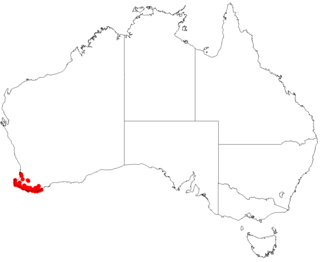
Billardiera laxiflora is a species of flowering plant in the family Pittosporaceae and is endemic to the far south-west of Western Australia. It is a delicate, twining shrub or climber that has linear leaves and white flowers tinged or spotted with pink or mauve.
Marianthus aquilonaris is a species of flowering plant in the family Pittosporaceae and is endemic to a restricted part of the southwest of Western Australia. It is an erect, multi-stemmed shrub with elliptic to oblong leaves and pale blue to almost white flowers arranged singly in leaf axils.

Marianthus bicolor, commonly known as painted marianthus, is a species of flowering plant in the family Pittosporaceae and is endemic to the southwest of Western Australia. It is a low, erect, spreading shrub or climber with narrowly elliptic leaves and white to cream-coloured flowers with maroon or purple striations flowers arranged in branched clusters.
















